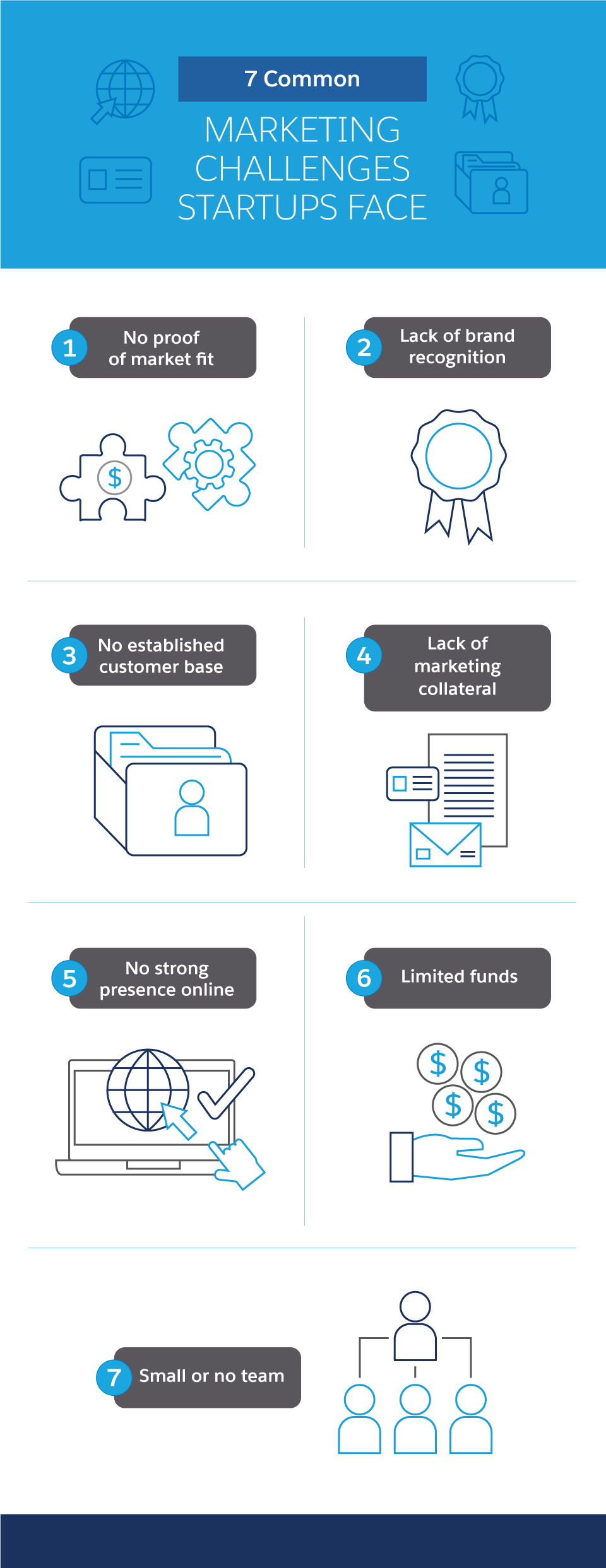You’ve got your business plan, website, and other essentials down pat. Now you’re ready to get your startup in front of the masses.
One question remains: How, exactly, do you reach potential customers?
If you don’t have a background in marketing, don’t fret; there are a number of low-cost, inexpensive, and even free ways to get your business in front of your ideal consumer.
For entrepreneurs who are ready to start marketing their startups, keep reading. This article will cover common challenges — and solutions — to help you market your new business successfully.

Marketing Your Startup: First Thing’s First
Before you get started with a marketing strategy for your startup, it’s essential to knock some early to-dos off your list. Here are three items to tackle before you put together a marketing plan.
1. Make Sure Your Website is Ready for Prime Time
After securing a domain for your business, make sure you have a UX- and mobile-friendly design for your site, meaning your website is easy for users to use and can be navigated on every screen size. Consider opting for automatic renewal for the domain name, hosting, and other site essentials, too, so you don’t have to worry about your website going offline — or another buyer claiming it — when your initial contracts are up.
From there, invest in marketing software so you can start laying the digital framework for your business. Integrating email software so visitors can contact you through the website, and then creating staple pages such as “About,” “Contact,” and “Services/Products” are good places to st.
2. Get Set Up on Social
Make sure you own your business name across social networks. You don’t need to actively use every social platform — nor should you try to — but it’s a good idea to capture your startup name across the major sites.
From Facebook to Twitter and TikTok, it’s a good practice to establish a profile with your company name in case your social strategy changes down the road, or just to get ahead of someone (or a competitor) scooping it up. At a minimum, you can create a profile on a social network and include your website URL in the bio to point interested users to your busines
3. Get Clear on Voice and Tone
Before you start communicating with your audience, you want to establish who you are and how you sound. If you offer a sophisticated service for high-income older users, your voice and tone will likely differ from a retailer producing a low-cost product for teenagers.
Once you identify who makes up your user base, how they communicate, and where they live online, you can form some key communication documents. From there, share them with your team so there’s an aligned brand voice across all channels.
Once you have these fundamentals in place, you’re ready for next steps.
Seven Common Challenges When Marketing Your Startup
Running your startup presents you with all sorts of exciting opportunities. Like anything when you’re new and potentially inexperienced, there will be learning curves and challenges.

For instance, you’re likely to encounter some combination of the following:
No proof of market fit. You always want to test your product with your dream customers early on. But you must do your due diligence and avoid forging ahead without testing and researching. Otherwise you run the risk of finding out the space is too crowded or, worse, that there’s no paying market for your service.
Lack of brand recognition. When you’re first starting out, it can be hard to stand out and make a splash as the new kid on the block.
No established customer base. Outside of close family and friends — or a successful influencer or growth marketing campaign — it takes a while to build a loyal community of people who want to regularly buy from you.
Lack of marketing collateral. Until you have case studies, user testimonials, and other metrics of success to share with your audience, it can be hard to get buy-in from potential clients.
No strong presence online. It takes time and money to create quality content that will help you rank organically on search engines. Unless you have a healthy advertising budget and expert guidance, it will take a while for your business to appear on the results pages for Google, Bing, and other search engines.
Limited funds. If you’re bootstrapping your startup, you want to be lean and smart with how you allocate your money. Because of this, you may not have a lot of cash on hand for a splashy website design or attention-getting promotional campaigns.
Small (or no) team. When you’re a scrappy new business, you may be a jack or jill of all trades in charge of, well, everything. When you’re spread thin, it can be difficult to prioritize any one area and take a while to execute on an action.
Thankfully, you can do work beforehand to learn if you need to pivot in order to get ahead of or avoid these challenges.
Seven Ways to Effectively Market Your Startup
Taking those challenges into consideration, let’s tackle how your startup can conquer them and emerge successful.
1. Research the Market and Confirm Your Product Fit
Not everyone will be your customer — and that’s a good thing. You want to get specific about your ideal user and your market so you can successfully match people with your offering.
Get clear on your ideal client and create a customer profile to match. Depending on your company’s offerings, you may have more than one. There are paid and free ways you can conduct market research for your startup; with this data, you can make more informed decisions about your business and better educate your team on the industry and your customers.
From there, test your value offering and review the competitive landscape, and tweak or pivot as needed.
2. Develop Your Brand Identity
Your marketing needs to have a personality, one that meets your ideal customer where they are. For example, clients want their financial management company to be competent, authoritative, and professional. A company that sells silly games for teenagers, however, will have a completely different personality.
Get clear on your brand voice, tone, and identity before you push out your first piece of marketing content. Make it consistent across channels — including on social media, in emails, and in printed collateral — and make sure everyone on your team knows what it is. You want customers to know early on who you are and what you’re about, especially when you’re introducing your startup to the masses.
3. Build a Loyal Community
Once your new business is out in the world (and even before, when you start conducting market research and prospecting), you need to find your people.
You can begin by developing social media and email marketing campaigns. Sponsored ads and blog posts are additional ways to get your brand in front of potential customers. You can advertise on search engines, social media, YouTube, industry email newsletters — the options are endless. Depending on your niche, you might consider growth hacking strategies, such as influencer marketing, to reach a large subset of your user base, too.
Once you start developing your community, don’t get comfortable: Engage with your followers, email recipients, viewers, and fans regularly. Follow up on questions and comments, produce regular content, and reward your most loyal audience members with discounts and incentives, such as sneak peeks of new products or services

4. Use Social Proof
Depending on your offering, e-books and case studies can be good tools to fuel sales for your company. Another option that works well for many types of businesses is social proof: Buyers like to hear about and see other people’s real-life experiences, especially when sizing you up against the competition.
You can use a third-party app or service to feature customer testimonials directly on your site. You can also share user-generated content across your social media channels. Encourage users to tag your company name or use a designated hashtag so you can easily find their posts and share their positive experiences with your business with your audience.
5. Incorporate a Content Strategy
A solid keyword and content strategy work together to help give your startup visibility online.
Conduct keyword research and implement the results into your content strategy. Then consider your options:
How often do you want to publish new content?
What will this content look like (including tweets, blog posts, infographics, email marketing)?
Where does this content live?
Figure out the answers to those questions and then post consistently to give your company name, products, and content a good chance of showing up online. From there, you’ll be able to connect with users who are already searching online for what you have to offer.
6. Create a Marketing Budget
From setting financial goals to determining operating costs to projecting cash flow, you need to develop a budget for your startup. Once you have those figures, you can break out budgets for different departments, including marketing.
Depending on your industry and where your key customers spend their time online and off, you want to allocate budget to advertise your startup. Test different channels and see what works best. Have some fun, too: Try a contest to get users excited about your business, for instance. You’ll collect data and encourage new users to engage with and share your brand.
7. Make Smart Hires
While you shouldn’t handle everything on your own long term, you do need to be mindful of the hires you bring on.
Early on in your startup journey, it might be tempting to do everything yourself or, alternatively, to hire a ton of team members. Consider slowly ramping up as needed or outsourcing your most pressing tasks to specialists or consultants. This is especially true if your startup serves a seasonal or fluctuating audience. Once you have a handle on your operation, workflow, and revenue, you can reassess your hiring needs.
Startups in the Wild
Like all businesses, startups have their own set of advantages and challenges. After you familiarize yourself with common roadblocks, you’ll be better equipped to tackle them head on so you can market your startup to the world.


